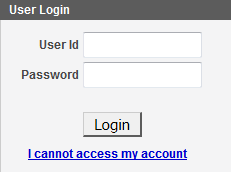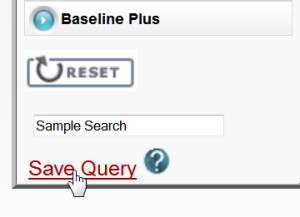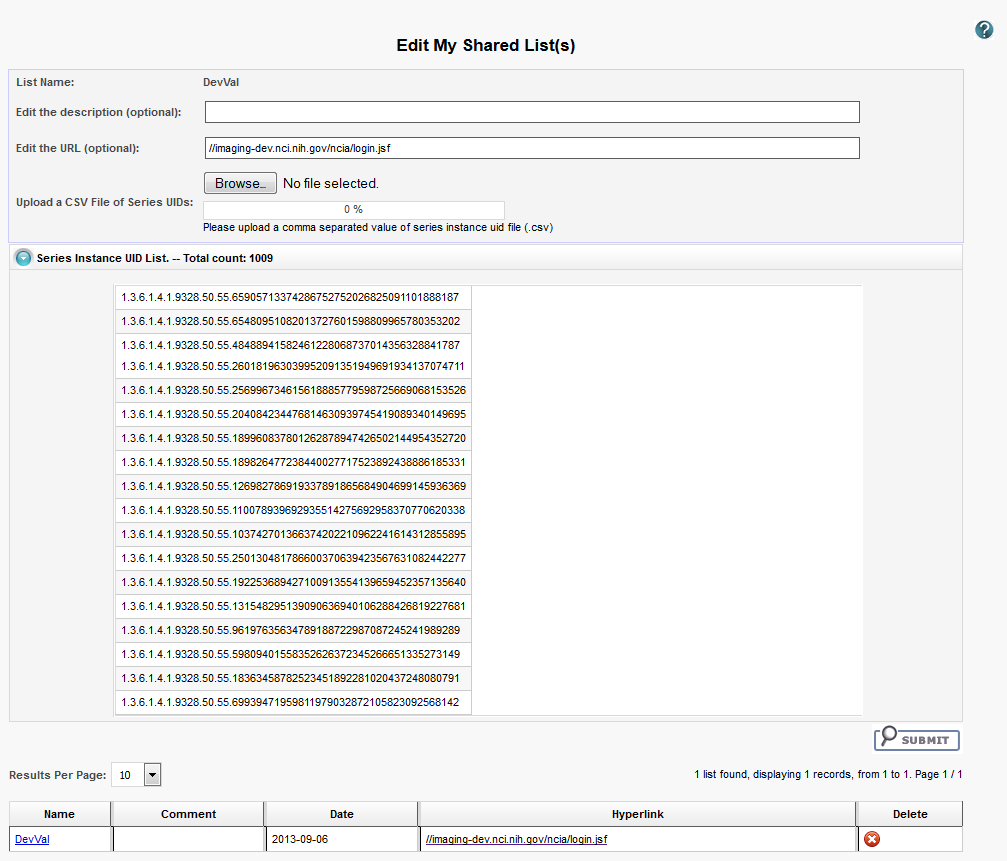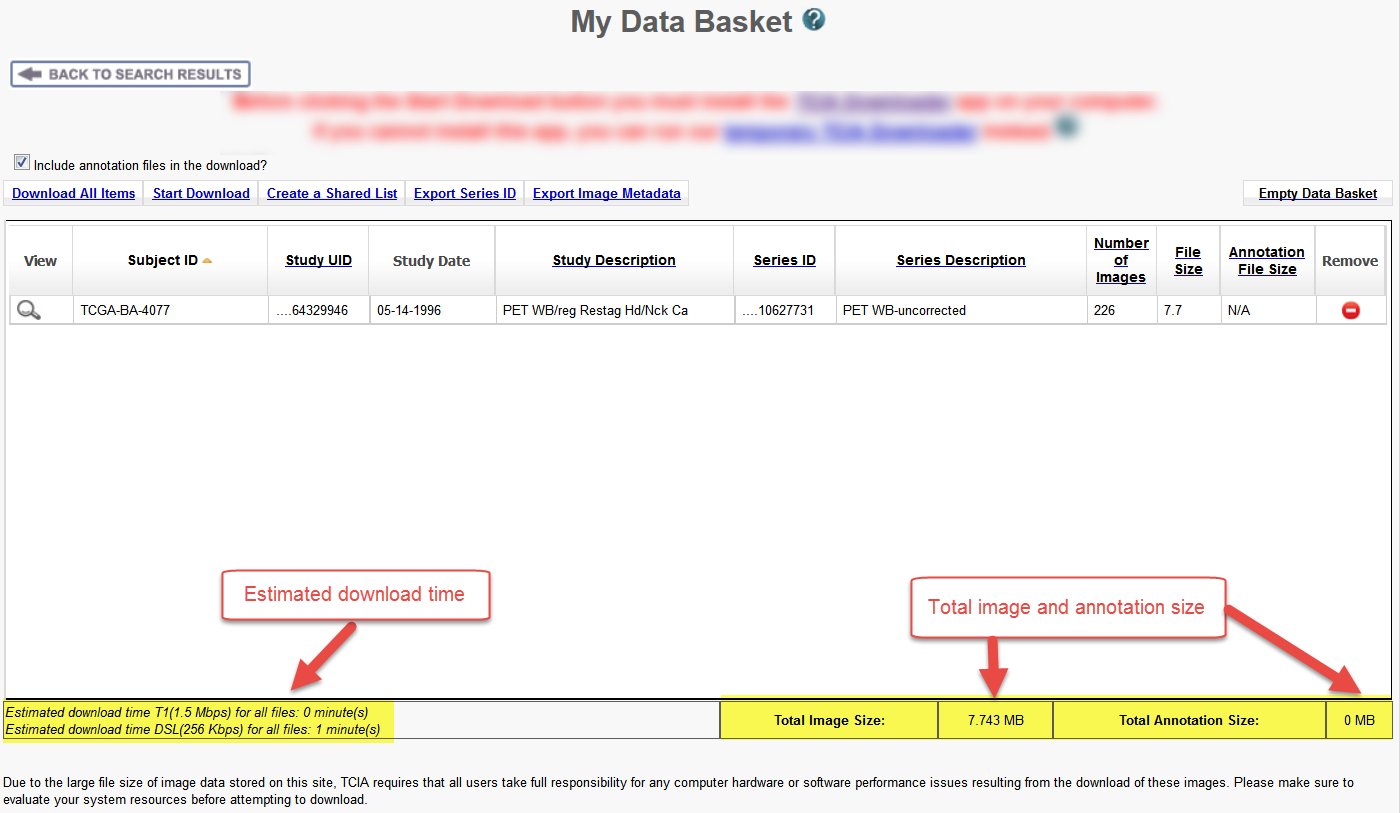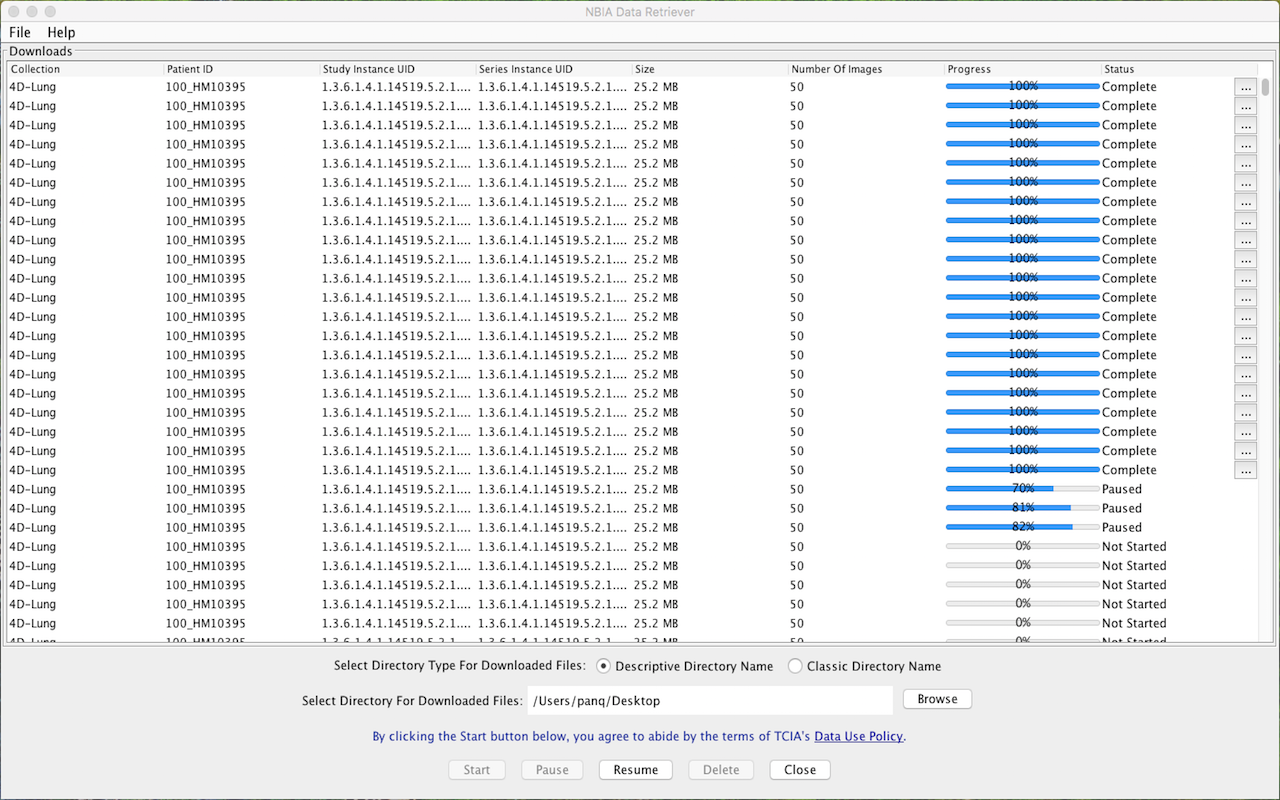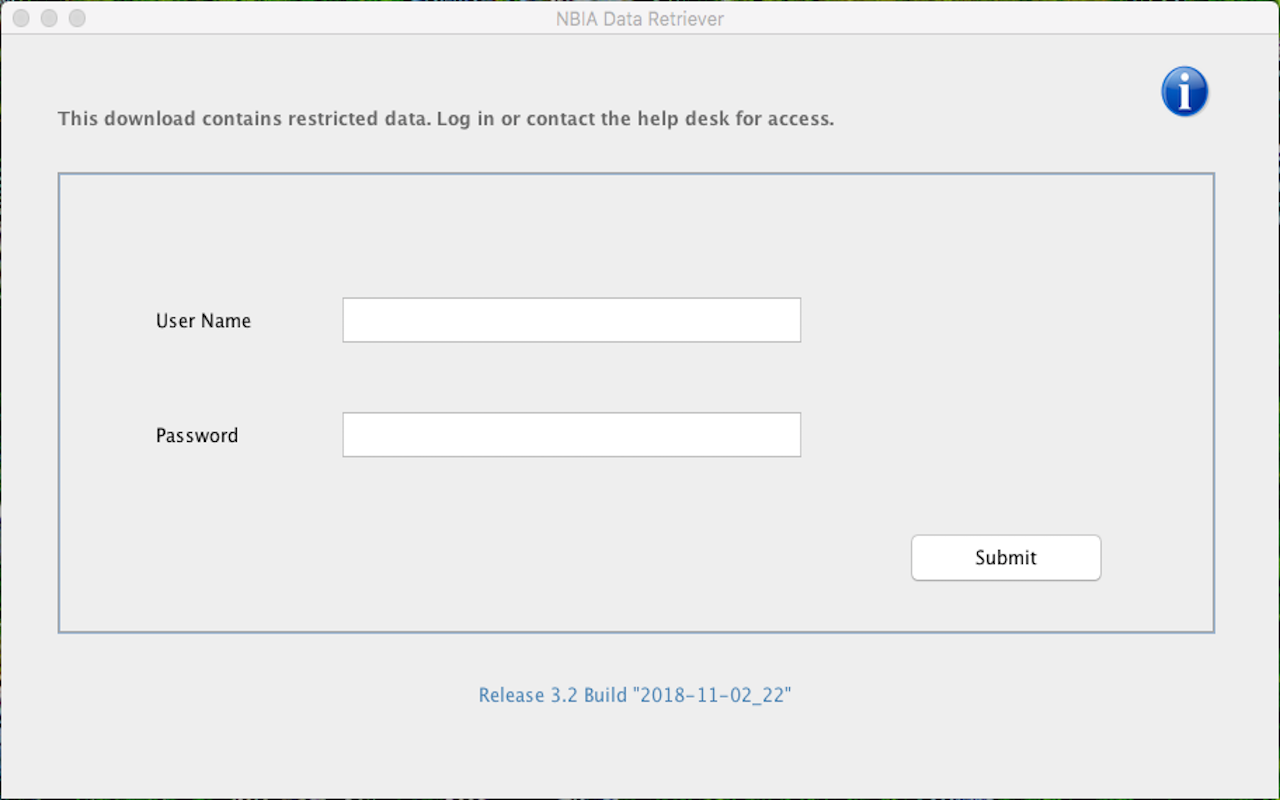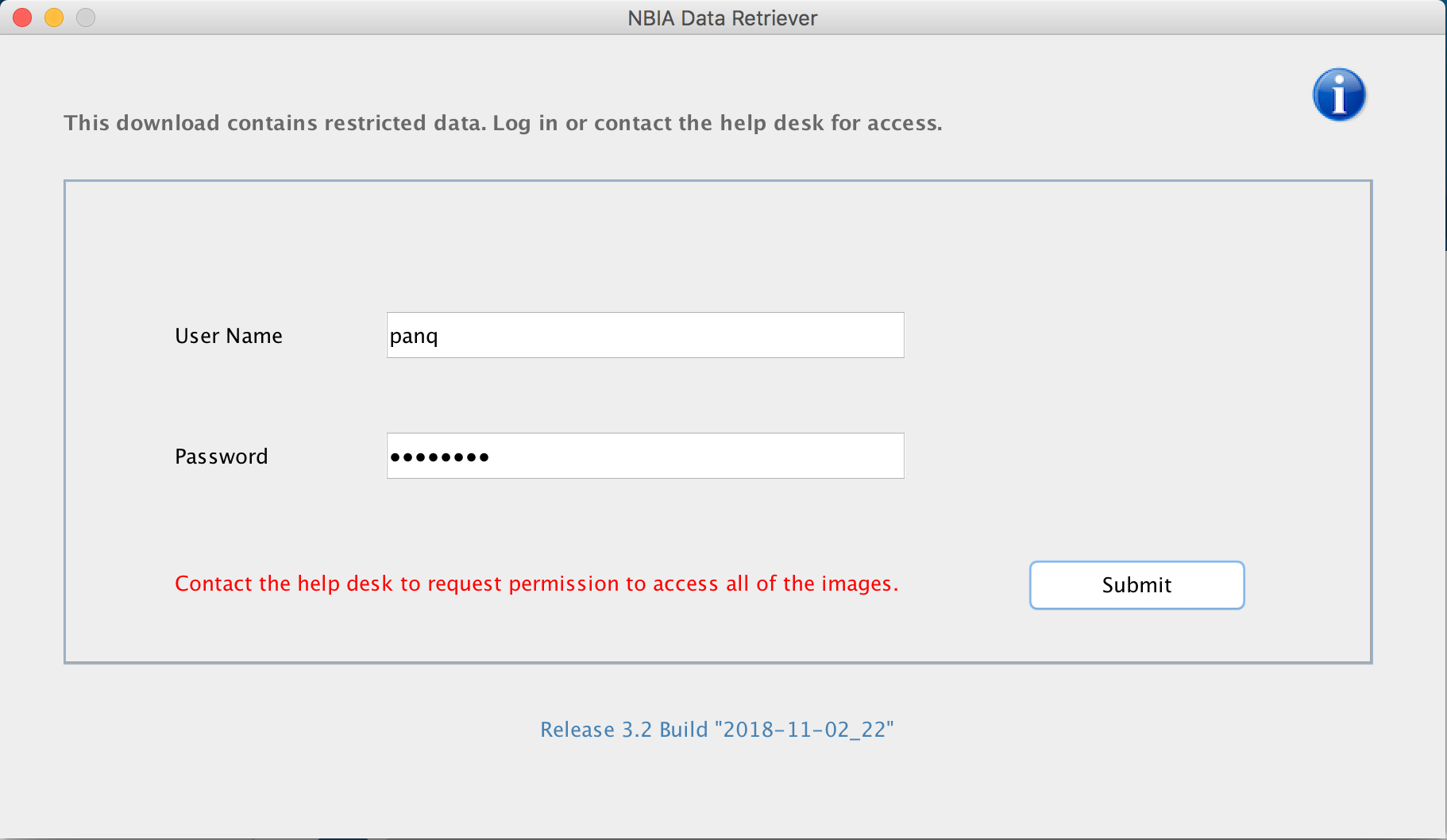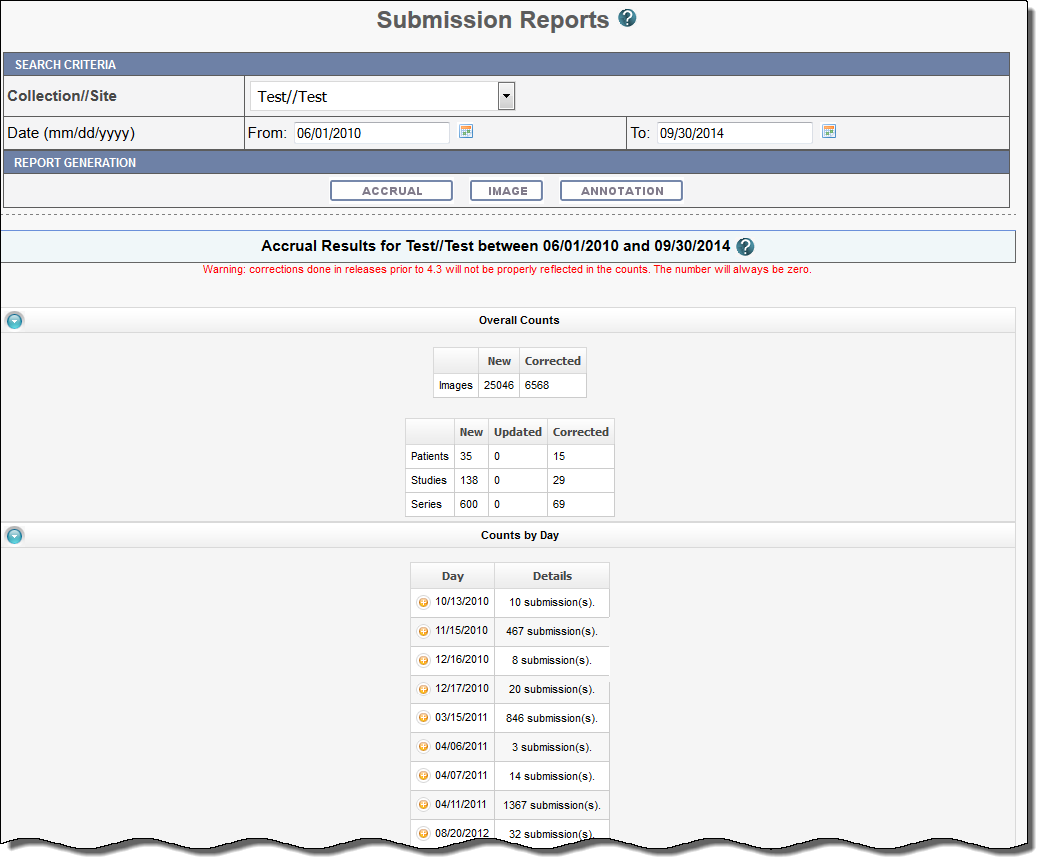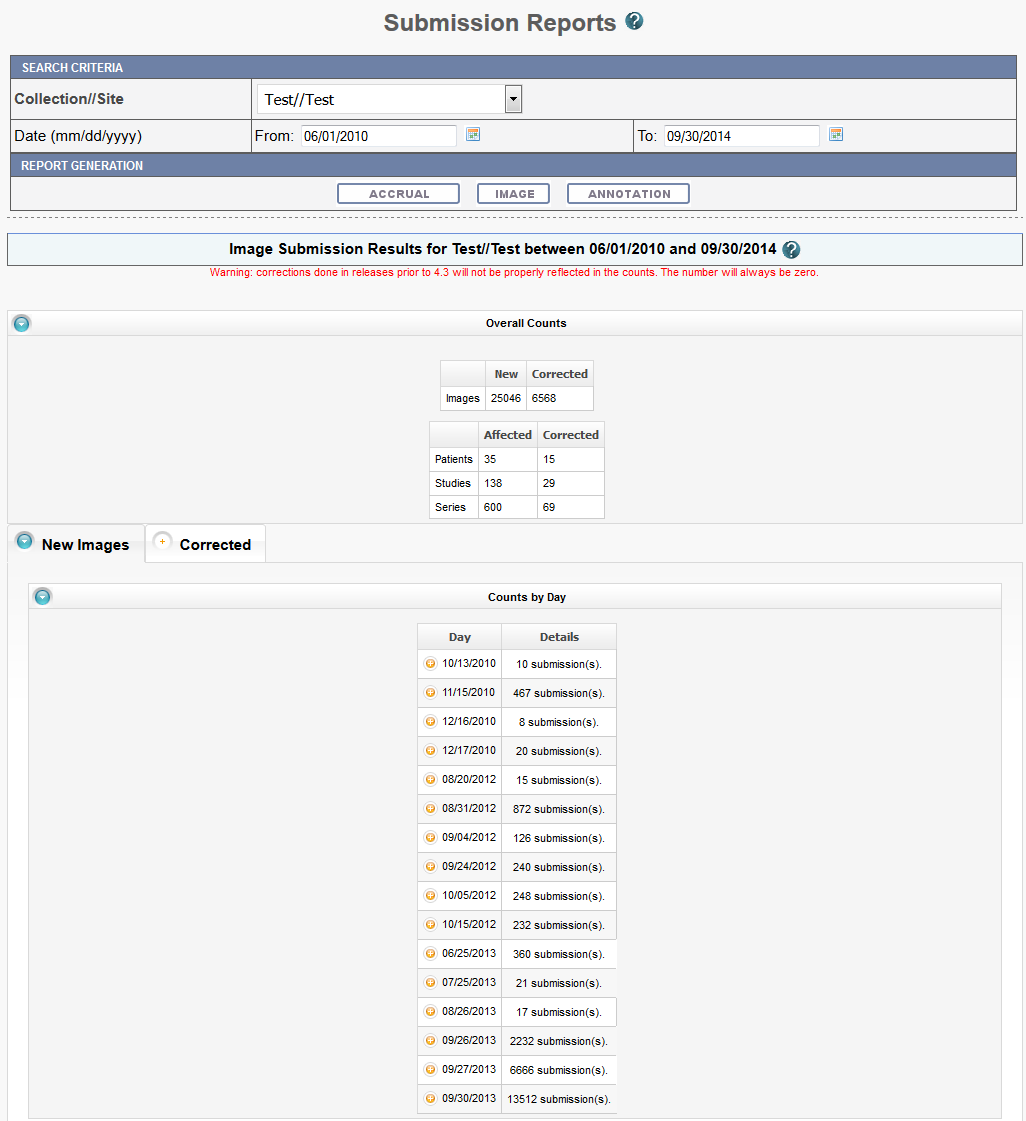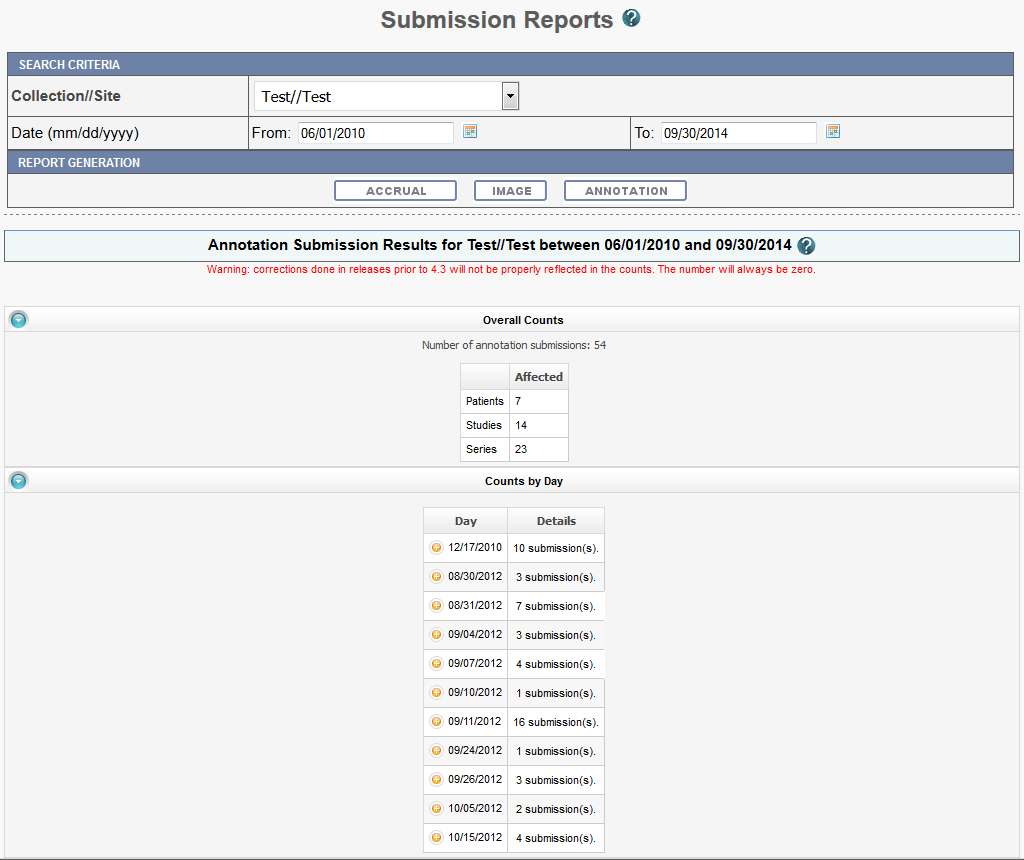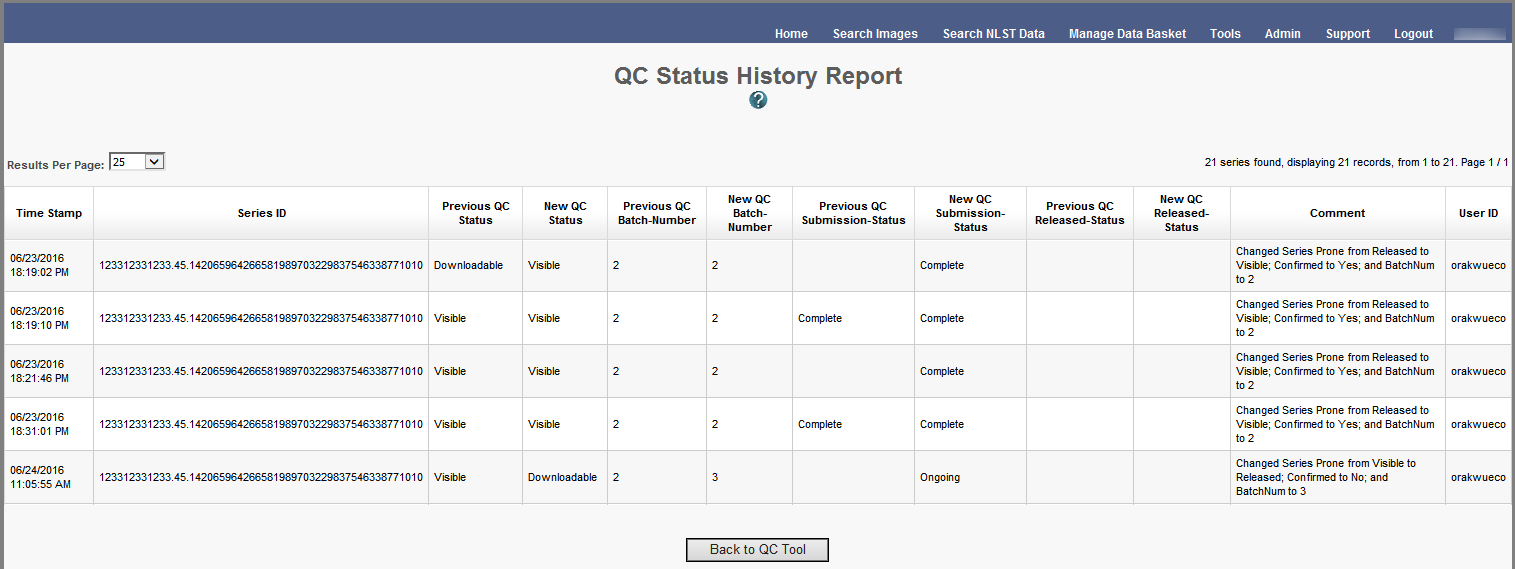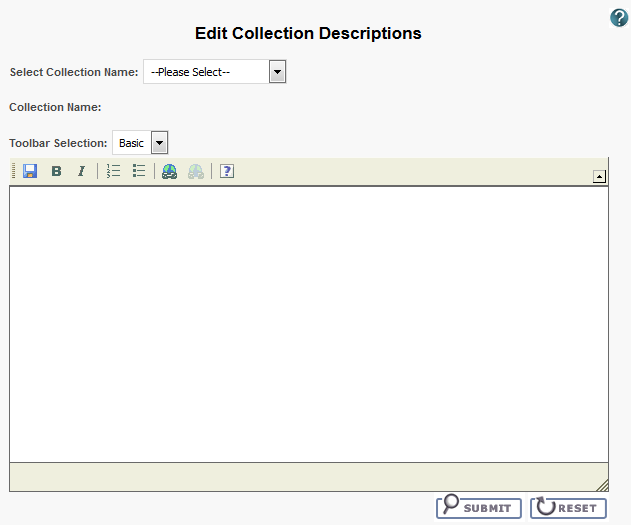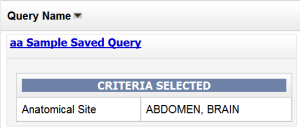Search the online help for NBIA:
This page contains the online help topics for the current release of NBIA. A full user's guide is also available.
Registering a New User
Logging into NBIA
If you do not have a User ID or password, click Register Now to apply for a user account. For more information, see Registering a New User.
If you have already registered, perform the following steps to log in.
- In the User Login panel, enter your User ID and password.
Click Login. If your login is successful, the data portal appears.
Tip
NBIA uses popups. To prevent problems accessing the application, in your browser, enable a popup blocker exception for https://imaging.nci.nih.gov/ncia/login.jsf.
If you have persistent difficulty logging in, click I cannot access my account on the NBIA login page. An NBIA account help topic opens, describing help options for resolving your login problem. Alternately, contact Application Support.
Using the NBIA Home Page
Using NBIA Online Help
Performing a Simple Search
Performing a Text Search
Performing an Advanced Search
Creating Saved Queries
- Select search criteria.
In the box above the Save Query link, enter a name for your query.
Click Save Query.
The query is saved. You can see it by selecting Tools > View Saved Queries.
Working with Saved Queries
The following procedures are associated with saved search queries.
Editing Saved Queries
Viewing Query History
Search Results Studies for Subject
Creating a Shared List
Who can create a shared list?
Anyone can create a shared list. Once you do so, you must record the exact name of the shared list to distribute to others who may want to use the list. That is the only way they can access it.
To create a shared list
You can create a shared list from data basket or the Tools menu. Procedures for both methods follow.
Data Basket
- Add an image series that you want to include in the shared list to the data basket.
- Click the Create Shared List button.
- Do the following:
- Enter a Name for the list (required).
- Optionally, add a description and a URL. The URL links to relevant or more detailed information about the list.
- Click Browse to upload a file in comma separated value format (.csv) that includes all of the series instance IDs you want to be in the shared list. This file should have one series instance UID per line.
- Click Submit.
The image series from the uploaded file is added to the data basket.
Access to your list
NBIA warns you that not all public users will have access to your list if the list contains any non-public image series.
Menu Option:
- Click Tools > Create Shared List.
The Create Shared List page appears.
- On this page, do the following:
- Enter a Name for the list (required).
- Add Comments and a Hyperlink, where appropriate, which links to relevant or more detailed information about the list (optional).
- In the Upload File field, enter the name of a file that includes all of the series instance IDs you want to be in the shared list. This file should have a series instance UID per line.
- For your convenience, a Java tool is available to aid in generating a CSV of your series instance UIDs.
Download: ExtractSeriesUIDs.zip
Do the following to use this tool to generate the file to upload in the last field of our online Create Shared List form:- Download the zip file, then move it to a top-level directory of DICOM files you want indexed.
- Extract the zip file to the top level directory where your DICOM data resides (all sub-directories will be scanned). It should extract two things.
- Then run ExtractSeriesUIDs.bat which should flash a quick command line window and then automatically disappear.
A file with a name similar to SeriesUIDs.CSV is created as an output. - Enter the output filename into the form.
- Click Submit.
The image series from the uploaded file is added to the data basket.
Searching a Shared List
To search for a shared list
- Log in to NBIA.
- Click Tools > Search Shared List.
The Search Shared List page appears.
- Enter the name of an existing shared list. To retrieve the list, you must know the exact name given to the shared list.
- Click Submit to launch the search or Reset to clear the field and start again.
If the search is successful, all image series in the shared list are added to the data basket. If the shared list includes series for which you do not have visibility rights, a message appears that informs you that the displayed shared list is not complete.
Editing a Shared List
.csv file with all the series instance IDs for the list. You can only edit/delete shared lists you have created yourself.Shared List
From the data basket, you can export image series instance IDs to a .csv file for later use in creating or editing a shared list. See Exporting a Shared List for more information.
To edit a shared list
- Click the Edit Shared List link under Tools on the menu bar.
The Edit My Shared List page appears, displaying a list of shared lists you have created.
- Click the name of the shared list you want to edit.
List details appear.
- In the description field, optionally enter a comment about the list or your edit.
- In the URL field, optionally enter a web address that provides more information about the shared list.
Click Browse to locate the file you want to upload. Doing this replaces the current shared list.
To delete a shared list
- Click Tools > Edit Shared List.
The Edit My Shared List page appears, displaying a list of Shared Lists you have created. - In the row of the shared list you want to delete, click .
Because editing a shared list is only possible by replacing it, you might consider backing up a shared list when you create it. To do so, export the shared list as a file when you create it. See Exporting a Shared List.
Managing a Shared List
Permissions
This administrative feature is available only to logged-in users who have "manage visibility" privileges, as defined in UPT.
To delete a shared list, follow these steps:
- Click Admin > Manage Shared List.
The Manage Shared List page appears.
- Select a user name from the list.
That user's shared list(s) appear.
Click the name link to review the shared list's details or click to delete shared the shared list.
Managing the Data Basket
You select items to download by first searching for them in NBIA and then adding them to your data basket.
The following is an example of the My Data Basket page with just one image collection in it. The estimated download time and the total size of your data basket appear at the bottom.
The following table describes each item in the table.
Data Basket Field | Description |
|---|---|
Subject ID | Subject identification number |
Study UID | Study identification number |
| Study Date | Date of study |
| Study Description | Description of the study |
Series ID | Series identification number |
| Series Description | Description of the series |
Number of Images | Number of Images for series |
Image Size (in MB) | Size of the image file in megabytes |
Annotation File Size (in MB) | Size of the annotations file in megabytes. This column is N/A if there are no annotations. |
Remove | Remove the item from the basket. |
To delete all items from your basket, click the Empty Data Basket link. You can continue to add items to your data basket from the Search Results pages.
Deletion details
If the series you mark for deletion is part of a shared list, a message appears alerting you to that fact. The message also includes the name of the shared list and the shared list creator's email address. This gives you the opportunity to back out of the deletion. For more information see Working With Shared Lists.
You can now download the data in your data basket using the Downloader. You must install the application before you proceed with downloading.
However, if you cannot download the application, the alternative is to use the Temporary Downloader, a Java Network Launch Protocol (JNLP) file previously called the NBIA Download Manager.
The Temporary Downloader allows you to replicate items in your Data Basket, downloading them to your local machine. It is a Java program and requires that you install a Java Runtime Environment (JRETM) on your machine to run it. You can download the JRE . The Temporary Downloader does not limit the total size of the download.
JRE
You must have version 8 or higher of the Java Runtime Environment (JRE) installed to be able to open the Download Manager.
- If JRE 8 is installed, the Temporary Downloader attempts to start. To run the application, you must click Run in the Warning dialog box indicating the application's digital signature cannot be verified. Before doing so, you can select the More Information... link at the bottom of the dialog to view a more detailed report of any security issues. Then you can evaluate whether you want to run the application.
- If JRE is installed but the version is older than version 6, the browser automatically attempts to upgrade the JRE to version 8.
If the JRE is not installed, when you click the Download Manager button, the browser prompts you for what it should do with the JNLP file. The My Data Basket page includes a link to a page where you can download the JRE.
If the Temporary Downloader fails to work properly, this could be a JRE version issue. The Temporary Downloader has been tested successfully with Version 8 Update 101.
Java Security settings
Java Security may block the installation of the Temporary Downloader. You may see a window like the following.
To resolve this issue, do the following.
- Select Start menu > Configure Java.
The Java Control Panel appears. - Select the Security tab.
- Click Edit Site List and then enter https://imaging.nci.nih.gov as the location.
- Click OK.
- Click the JNLP file to run the Temporary Downloader again.
A message window appears, asking you if you want to run this application. - Select I accept the risk and want to run this application.
- Click Run.
The Temporary Downloader successfully launches.
Removing items
The Temporary Downloader initially lists everything in your data basket. You can remove items from the Downloads list in the Temporary Downloader that you do not want to download. When you remove an item from the list, it remains in the data basket. You just do not download it.
To download objects using the Temporary Downloader
Mac OS X
The following instructions apply to Windows PCs but you can also use the Temporary Downloader on Mac OS X .
- At the top of the My Data Basket page, click the Download Manager link. You are prompted to open or save the temporary Downloader. Open it in the JRETM you installed. If you have any issues opening the Temporary Downloader, see the note about Java Security settings.
The page lists all items you selected in the data basket. You can hover your mouse over the Patient ID, Study Instance, and Series Instance columns to reveal the complete corresponding IDs. You can also resize a column by selecting and dragging the column border. - Click Browse to navigate to the destination where you want the images/annotations to be downloaded.
Click Start to begin the download. You can monitor the download in the Progress column. The Status column indicates when the download for each item is complete.
At any point in the process, you can click the Pause and Resume buttons to temporarily stop and restart the process.
Note that files downloaded this way are not compressed. The downloaded files are stored in a child folder under the destination folder such as
Collection name/patient id/study instance UID/series instance UID/image SOP instance UID.
Removing items
The Temporary Downloader initially lists everything in your data basket. You can remove items from the Downloads list in the Temporary Downloader that you do not want to download. When you remove an item from the Downloads list, it remains in the data basket. You just do not download it.
Network error?
Downloading NBIA Images
Downloading the NBIA Data Retriever
Click one of the following links to download the NBIA Data Retriever for that operating system.
- Windows
- Mac: NBIA Data Retriever in the Mac App Store
- RPM (tested on CentOS)
To run this file, type the following at the command prompt:sudoyum -v -y remove TCIADownloader.x86_64;sudoyum -y install NBIADataRetriever -3.2-1.x86_64.rpm - DEB (tested on Ubuntu)
To run this file, type the following at the command prompt:sudo -S dpkg -r tciadownloader;sudo -S dpkg -i nbia-data-retriever-3.2.deb
After you search for images of interest and add them to your data basket, you can download them.
The most convenient method of downloading is by using the NBIA Data Retriever. You must install the NBIA Data Retriever before you begin downloading. You only have to install it once to use it in future downloading sessions.
Consult the NBIA Data Retriever FAQ for more information about NBIA Data Retriever versions and usage.
If you cannot install the NBIA Data Retriever for any reason, you can run the TCIA Download Manager (JNLP) instead.
Installing the NBIA Data Retriever
To install the NBIA Data Retriever on Windows
- Download the installer package for Windows using the link above.
- Save the installer package file to your computer.
- Install the app by double-clicking the installer package file.
- Agree to the terms in the License Agreement and click Install.
- When the Setup Wizard ends, click Finish.
To install the NBIA Data Retriever on Mac
The Mac version of the NBIA Data Retriever is only available through the iOS App Store. It requires a manifest file to work. You can download the app first or create a manifest file first. If you download the app first, right-click the manifest file and select Open With NBIA Data Retriever. If you create a manifest file first, right-click it and select Open With App Store. This installs the app and then opens the manifest file in the app.
On your Mac, find the NBIA Data Retriever on the Mac App Store.
The NBIA Data Retriever is free but still requires you to log in to download it. Consider changing your iOS Password Settings so that you can download free software without having to log in separately for it.
- Click Get, then click Install App. The NBIA Data Retriever is free.
The app starts downloading to your Mac. When the download is complete, you can open a manifest file with the NBIA Data Retriever.
To install the NBIA Data Retriever on Linux (centOS or Ubuntu)
You must have the sudo privilege on your computer and a sudo password to install the NBIA Data Retriever on CentOS and Ubuntu.
- Download the installer package for centOS or Ubuntu using the links above.
- Save the installer package file to your computer.
- Open a command window and go to the location where you saved the installer.
- For a centOS system, enter the following at the command prompt:
sudo yum -v -y remove TCIADownloader.x86_64;sudo yum -y install NBIADataRetriever -3.2-1.x86_64.rpm - For an Ubuntu system, enter the following at the command prompt:
sudo -S dpkg -r tciadownloader;sudo -S dpkg -i nbia-data-retriever-3.2.deb
Enter the sudo password when prompted.
- For a centOS system, enter the following at the command prompt:
Downloading Images Using the NBIA Data Retriever
When you start downloading the images you have added to the data basket, NBIA provides a list of those images in a manifest file (manifest-xxx.tcia). You must have already installed the NBIA Data Retriever to open this manifest file and download the images.
You can share the manifest file with collaborators so that they can download the same images that you have added to your data basket. Collaborators must also install the NBIA Data Retriever to open the manifest file.
If you want to share a manifest file that includes links to private image collections, you must first manually install the latest NBIA Data Retriever. The latest version of the NBIA Data Retriever controls access to private collections. In addition, your collaborators must have the same access to those private collections as you do. Otherwise, your collaborators will not be able to download images from those collections.
- Search for images of interest.
- Add those images to your data basket.
- Open the My Data Basket page and click Start Download.
Click the
manifest-xxx.tciafile.
If you are only downloading public images, the NBIA Data Retriever appears, listing the items in your data basket. If you are downloading any private images, see the section about downloading private data.The NBIA Data Retriever lists all items you selected in the data basket. You can hover your mouse over the Patient ID, Study Instance, and Series Instance columns to reveal the complete corresponding IDs. You can also resize a column by selecting and dragging the column border.
If you do not want to download any of those items, select them in the Downloads table and then click Delete. When you remove an item from the Downloads table, it stays in your data basket.
Click Browse to navigate to the destination where you want the images/annotations to be downloaded.
Click Start to begin the download. You can monitor the download in the Progress column. The Status column indicates when the download for each item is complete.
At any point in the process, you can click the Pause and Resume buttons to temporarily stop and restart the process.
Note that files downloaded this way are not compressed. The downloaded files are stored in a child folder under the destination folder such as
Collection Name > Patient ID > part of Study Date + part of Study ID + part of Study Description + last 5 digits of Study Instance UID > part of Series Number + part of Series Description + last 5 digits of Series Instance UID.Network Error?
If network errors occur during large downloads, the NBIA Data Retriever retries the files the number of times that your administrator has configured.
Downloading Private Data
If you are downloading any private data, you are prompted to log in.
Once you log in, the NBIA Data Retriever appears.
If you do not have permission to access even one of the collections/sites to which the images you have in your manifest file, you are prompted to contact the help desk to request permission to access all of the images.
Viewing Submission Reports
For more information about roles, see Creating a New NBIA User.
When a site submits images to NBIA, a user with admin privileges can run various reports to verify that the images have been received and to monitor the status of the submitted images. This is accomplished in NBIA by generating a report with this information.
To view submission reports, follow these steps:
- Click Admin > View Submission Reports.
The Submission Reports page appears.
The Collection//Site section displays all collections for which you, as an Admin, have permissions to view. - Select a collection.
- Enter a valid date range or select one by clicking the calendar icons.
- Click the report type you want to run: Accrual, Image, or Annotation.
The search begins and may take a few moments.
To assist in viewing the reports, use the following icons:
- In the report results in the upper right segment of the page, click the Help button () to learn details about the report type you selected.
- Click the arrow at the left of the section to hide () or show () the results.
- To view an expanded view of the image report results, click the Expand icon () preceding each row of the New Image or Corrected summaries.
The results display Count by Day details of the submissions. For example, for each day in the time frame, you can view a list of affected patient IDs, study instance UIDs and series instance UIDs.
Accrual Report
Fields that appear on the report are described in the following table.
Submitted Files Counts Fields | Description |
|---|---|
New Image | An image that does not exist in the system at the time of submission |
Corrected Image | An Image that has been successfully submitted more than once. The time of the original image submission does not affect whether a subsequent image is considered as "corrected". Each time, an image is re-submitted in the time frame, the count is incremented. |
New Patient | A patient that had no images submissions prior to the start of the date range, but at least one image submission within the date range |
Updated Patient | A patient that had at least one image submission prior to the start of the date range, and at least one image submission within the date range |
Corrected Patient | A patient that has at least one image submission in the time frame that has been corrected. |
New Study | A study that had no image submissions prior to the start of the date range, but has at least one image submission within the date range |
Updated Study | A study that had at least one image submission prior to the start of the date range, and at least one image submission within the date range |
Corrected Study | A study that has at least one image submission in the time frame that has been corrected. |
New Series | A series that no image submissions prior to the start of the date range, but has at least one image submission within the date range |
Updated Series | A series that had at least one image submission prior to the start of the date range, and at least one image submission within the date range |
Corrected Series | A series that has at least one image submission in the time frame that has been corrected |
Report content
The reports contain a count of patient/study, series or images that have been affected during the date range in the specified collection/site.
Image Submission Report
Image submission results display a count of patients, studies or series for or to which an image was submitted during the specified date range in the collection or site you selected. Fields that appear on the report are described in the following table.
Submitted Files Counts Fields | Description |
|---|---|
New Image | An image that does not exist in the system at the time of submission |
Corrected Image | An Image that has been successfully submitted more than once. The time of the original image submission does not affect whether a subsequent image is considered as "corrected". Each time, an image is re-submitted in the time frame, the count is incremented |
Affected Patient/Study/Series | A patient/study/series is one for which there was at least one new image submission |
Corrected Patient/Study/Series | A patient/study/series that has at least one image submission that has been corrected in the time frame. |
Report content
The reports contain a count of patient/study, series or images that have been affected during the date range in the specified collection/site.
Annotation Submission Report
The annotation submission report contains a count of annotations submitted and affected patient/study/series during the specified date range for that collection site. Fields that appear on the report are described in the following table.
Submitted Files Counts Fields | Description |
|---|---|
Annotation | An annotation that has never been submitted in the system prior to the start of the date range |
Corrected Image | A patient/study/series is one for which there was at least one new annotation submission |
Report content
The reports contain a count of patient/study, series or images that have been affected during the date range in the specified collection/site.
Using the Quality Control Tool
Generating a QC Status Report
The QC Status History Report appears, displaying all changes that have been made to the status of the series you selected.
Click Back to QC Tool to close this window and return to the QC tool.
Approving Image Deletions
For more information about roles, see Creating a New NBIA User.
This function is part of a two-tier deletion process. A super curator can approve the deletion of image series that have been identified as "To be deleted".
To approve series deletions, follow these steps:
- Click Admin > Approve Deletions.
The Approve Deletions page appears. - From the Collection(s) list, select a collection (site).
- Optionally, enter Patient IDs. Separate multiple IDs by commas.
- Click Submit to initiate a search for the series marked for deletion.
From the results, click View to review the detail for an individual series. From the page that opens, click Delete to approve the deletion. Click the Skip button to go to the next series.
Tip
If you click Skip, this signals that you do not approve the deletion. If that is so, you should generate a report to see who requested the deletion and work with that person to resolve any deletion disagreement.
- For batch deletion, select the checkbox for one or more series and click Delete to approve the deletion.
Image series approved for deletion are still visible in the system, identified as "To Be Deleted". They are removed from the system at a system-configured time, such as at midnight (called an "off-line deletion"), unless a manual deletion (called an "online deletion") is performed. For more information, see Manually Deleting Image Series.
About deletions
- After an image series is approved for deletion, the action cannot be reversed.
- Any new image submissions to a series identified "To be deleted" will be successful, but the status of the series does not change.
- Images submitted to files that are identified as "Deleted" are quarantined.
Manually Deleting Image Series
For more information about roles, see Creating a New NBIA User.
This function is part of a two-tier deletion process. You can execute the online deletion of image series that are approved for deletion. This immediately removes images that are approved for deletion rather than requiring you to wait for the next scheduled system-wide deletion job.
To manually delete series, follow these steps:
- Click Admin > Perform Online Deletion.
A list of image series that have been approved for deletion appears. Click Delete to execute the real-time series removal.
Deleting individual series?
All series listed in this page are deleted. There is no way to specify individual series for online deletion.
Editing a Collection Description
For more information about roles, see Creating a New NBIA User.
This feature allows you as an administrator to enter a brief description for a collection so the NBIA user knows what type of data comprises the collection.
To edit a collection description, follow these steps:
- Click Admin > Edit Collection Description.
The Edit Collection Descriptions page appears. - From the Select Collection Name list, select a collection name.
- In the text box, enter a description or edit an existing description for the collection. Use the text formatting tools to format the text, if you like. If appropriate, you can add a hyperlink to a resource such as a wiki with a longer description.
The description displays on the simple/advanced search screen when you click the (?) button next to the collection name.
Creating a clickable link
To make a link clickable in this section, select Rich for Toolbar Selection, select Source (), and create a link as shown in the following example:
<span contenteditable="false"><a href="https://www.google.com" target="_blank"><span>Link To Be Created</span> </a></span></p>
If you want to edit the link, select the Source button and set contenteditable to true.
Managing Workflow Items
For more information about roles, see Creating a New NBIA User.
A workflow is a business process that, in the case of NBIA, an image series must pass through before it is published. Since it is a business process, these steps must be defined first within an organization. NBIA allows you to change the visibility status of an image series. This visibility change is part of the definition of a workflow item. Workflow items can also trigger a web service call to a URL. When you define a workflow item, you specify a name for it, the type of action that will take place during it (such as a visibility change), which image collection and site are involved, and the URL of a web service if the information resulting from this workflow item should be sent to one.
You can create, edit, and delete workflow items
Creating a Workflow Item
- Select Admin > Manage Workflow Items.
The Manage Workflow Items page appears. - Click Create Workflow.
The Workflow Item page appears. In the Name box, specify a name for the new workflow item. The name cannot be longer than 50 characters.
From the Type list, select Visibility Change or New Series.
Select the Visibility Change option when editing an existing workflow item. A visibility change occurs when the workflow item triggers a web service call to the URL you have entered in the URL field on this page.
Select the New Series option if you want the result of this workflow item to create a new image series. You can add this new series to a collection in the next step.
- From the Collection list, select an existing image collection to which this workflow item should apply. Existing image collections are in the Collection list. If you need to create a new collection to apply to this workflow item, enter it in the New Collection for List box and then click Add to Collection List.
- From the Site list, select an existing site. Existing sites are in the Site list. If you need to create a new site to apply to this workflow item, enter it in the New Site for List box and then click Add to Site List.
- To send information in this workflow item to a web service, enter the web service's URL in the URL box.
- Click Save.
The new workflow item appears on the Manage Workflow Items page.
Editing a Workflow Item
You can edit a workflow item's name and collection/site.
To edit a workflow item
- Select Admin > Manage Workflow Items.
The Manage Workflow Items page appears.
- Click the in the row of the workflow item you want to edit.
The Workflow Item page appears, showing the values already set for the workflow item you selected.
- Edit the name, type, collection, site, or URL as needed, consulting Creating a Workflow Item for details on these steps.
- Click Save.
Deleting a Workflow Item
To delete a workflow item
- Select Admin > Manage Workflow Items.
The Manage Workflow Items page appears.
- Click in the row of the workflow item you want to delete.
You are prompted to confirm the deletion.
Creating Workflow items
- Select Admin > Manage Workflow Items.
The Manage Workflow Items page appears. - Click Create Workflow.
The Workflow Item page appears. In the Name box, specify a name for the new workflow item. The name cannot be longer than 50 characters.
From the Type list, select Visibility Change or New Series.
Select the Visibility Change option when editing an existing workflow item. A visibility change occurs when the workflow item triggers a web service call to the URL you have entered in the URL field on this page.
Select the New Series option if you want the result of this workflow item to create a new image series. You can add this new series to a collection in the next step.
- From the Collection list, select an existing image collection to which this workflow item should apply. Existing image collections are in the Collection list. If you need to create a new collection to apply to this workflow item, enter it in the New Collection for List box and then click Add to Collection List.
- From the Site list, select an existing site. Existing sites are in the Site list. If you need to create a new site to apply to this workflow item, enter it in the New Site for List box and then click Add to Site List.
- To send information in this workflow item to a web service, enter the web service's URL in the URL box.
- Click Save.
The new workflow item appears on the Manage Workflow Items page.
Managing Saved Queries
For more information about roles, see Creating a New NBIA User.
You can review and delete queries saved by users in NBIA.
Topics in this section:
Reviewing Saved Query Information
To review a saved query
- Select Admin > Manage Saved Queries.
The Manage Saved Queries page appears listing all the queries saved by NBIA users. The following information is listed for each query.
Column Name Description Query Name Click the name of the query to display the Criteria Selected by the user. The selected field name(s) and data are listed.
Last Executed Lists the date and time that the query was run. New Data Available indicates that new data is available.Query Creator Username of the person who saved the query.
Deleting a Saved Query
To delete a saved query
- Select Admin > Manage Saved Queries.
The Manage Saved Queries page appears. Check the box next to the Query Creator column of a query to be removed. You can delete multiple queries at once.
Removing All Saved Queries
To remove all of the saved queries, check the box next to column name, Query Creator. All queries are selected.
- Click Remove Selected Items.
You are prompted to confirm the deletion and the selected queries are removed.

